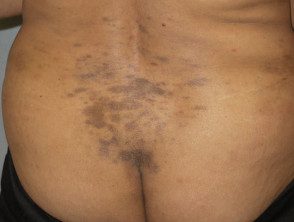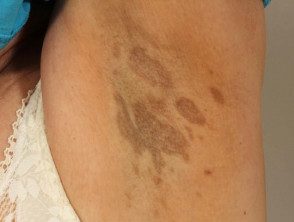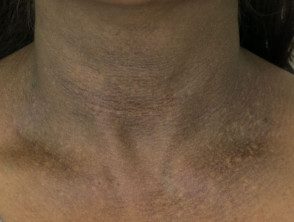What is acquired dermal macular hyperpigmentation?
Acquired dermal macular hyperpigmentation comprises three conditions:
- Erythema dyschromicum perstans
- Lichen planus pigmentosum
- Idiopathic eruptive macular hyperpigmentation [1,2].
The term acquired dermal macular hyperpigmentation is useful because the three conditions overlap. The subtypes can manifest in the same patient, and lack a clear clinical and histological differences [3]. However, hypermelanosis can have different causes.
Acquired dermal macular hyperpigmentation

Lichen planus pigmentosum of the lower back

Acquired dermal macular hyperpigmentation

See more images of acquired macular hyperpigmentation.
Who gets dermal macular hyperpigmentation?
the epidemiology Acquired dermal macular hyperpigmentation varies by subtype.
It can affect any age, genderand ethnicity, and tends to affect dark skinned patients. Asian, Middle Eastern and Latin American women between the second and fourth decades of life are the most affected [4].
What causes acquired dermal macular hyperpigmentation?
The exact cause of acquired dermal macular hyperpigmentation is unknown.
Theories proposed for the Pathogenesis of acquired dermal macular hyperpigmentation include:
- Genetic susceptibility
- Exposure to ultraviolet light (UV) radiation
- Contact reaction to a chemical (up to 36% of patients reported positive patch reaction test to hair dye) [5]
- Exposure to a medication such as hydroxychloroquine.
- A viral infection.
What are the clinical features of acquired dermal macular hyperpigmentation?
Acquired dermal macular hyperpigmentation presents with blue or grayish brown maculeswhich can be resized and morphology overtime.
-
Lichen planus pigmentosum and idiopathic eruptive macular hyperpigmentation affect the face, neck, and proximal extremities
-
Erythema dyschromicum perstans affects the trunk and locations protected from the sun [3].
Acquired dermal macular hyperpigmentation is usually asymptomaticalthough the lichen planus pigmentosum is sometimes pruritus in its early stages
What are the complications of acquired dermal macular hyperpigmentation?
No harmful long-term serious medical complications arise from acquired dermal macular hyperpigmentation. However, it has a high impact on the quality of life in people with colored skin due to cosmetic visibility and slow resolution.
How is acquired dermal macular hyperpigmentation diagnosed?
The diagnosis of acquired dermal macular hyperpigmentation and its subtypes are based on the cutaneous features and detailed history.
Patch testing may be indicated to exclude allergic contact dermatitis if there is a possible contact factor.
Dermoscopy is useful in the diagnosis and monitoring of acquired dermal macular hyperpigmentation. Findings may include [6]:
- Pigmented dots, globules and diffuse leftover areas eccrine and hair follicle openings
- Prominent normal pseudoreticular pigmentary network
- Telangiectasia
- Owl eye structures.
Histological characteristics of skin-acquired dermal macular hyperpigmentation. biopsy include:
- Melanin and melanophages at dermis
- Lichenoid change with a interface dermatitis [1,3].
Which is the differential diagnosis for acquired dermal macular hyperpigmentation?
A variety of other skin conditions appear similar to acquired dermal macular hyperpigmentation, such as:
- Post-inflammatory hyperpigmentation
- Drug-induced hyperpigmentation
- Multiple fixed drug injuries. eruption
- Macular amyloidosis
- Maculopapular cutaneous mastocytosis
What is the treatment for acquired dermal macular hyperpigmentation?
Treatment of acquired dermal macular hyperpigmentation depends on the subtype and its duration.
- Any identified contact allergen It should be avoided.
-
Colchicine has been used to improve macrophage activity and therefore clear dermal pigmentation [7].
- At acute inflammatory stage of lichen planus pigmentosum, current steroids, a topical calcineurin inhibitor and oral corticosteroids can be considered [8].
- In later stages or where there is no acute inflammation, the treatment aims to reduce pigmentation; Strict sun protection is recommended. Current retinoids can reduce melanin that is retained within the epidermis.
- Suggested treatments for erythema dyschromicum perstans have included dapsone, clofazimine, corticosteroids, and immunosuppressants without much evidence of effectiveness [3,9,10].
-
Idiopathic eruptive macular hyperpigmentation has been shown to resolve spontaneously in weeks or years.
- What is the result of acquired dermal macular hyperpigmentation?
Acquired dermal macular hyperpigmentation can persist for months or years, and possibly be followed by post-inflammatory hyperpigmentation, or relapse [3].
